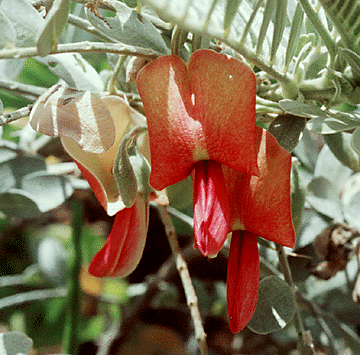



U.S. Fish and Wildlife Service
This ohai, scientific name Sesbania tomentosa,
had been found on all the main islands except Niihau,
but is now in danger of becoming extinct.
Once upon a time, a very long time ago, Hawaii had blind cave spiders, predatory caterpillars, flightless ducks and more than a hundred beautiful lobelia plants found nowhere else on earth. They're gone now, all of them. Extinction is a natural process, but we've improved on nature. Extinction here began accelerating 1,500 years ago with the arrival of the early settlers from the South Pacific, and sped up in the late 1700s with the arrival of the Europeans. These plants
need your helpA list of 245 endangered
Hawaii species is availableToday, native plant and bird extinction rates are thousands of times greater than the natural rate in other parts of the world. According to the Center for Plant Conservation, somewhere between 15 and 30 percent of all endangered U.S. plants are found in Hawaii. We are the extinction capital of the country, the Dr. Kevorkian of conservation.
To reverse the process, or at least to halt it, the U.S. Fish and Wildlife Service by court order must "publish proposed critical habitat designations or nondesignations for at least 100 federally listed Hawaiian plant species by Nov. 30, 2000, and to publish proposed rules for an additional 145 listed plants by April 30, 2002." Like much government writing, this requires considerable translation into English as we know it.
"Plants and Flowers of Hawai'i"
Conservationists hope to save this akoko, with t
he scientific name of Chamaesyce celastroides,
that is native to Oahu.
A "critical habitat" for threatened or endangered species is a specific area occupied by the species that is essential to the conservation of the species and which may require special management and protection.A "nondesignation" (and my computer highlights it as a nonword) means that a critical habitat may be excluded from public identification, if specifying the exact location may lead to vandalism, increasing the danger of extinction rather than lessening it.
"Listed" means that the plant has been declared endangered (in danger of extinction) or threatened (likely to become so in the foreseeable future.)
A public notice has been printed in the newspaper in the last week asking for public comments on the re-evaluation of whether "designation of critical habitat is prudent" for these 245 plants. For "prudent," consult "nondesignation." If it seems that defining an area publicly would do more harm than good, then nondesignation is prudent. See, it gets easy after a while.
There are 245 native plants on the list, including Delissea undulata and Cyanea recta which are now thought to be extinct. Both are forms of the lobelia family -- woody plants, shrubs and small trees with large brightly colored flowers that were once found on Maui.
There is Labordia lydgatei that the Center of Plant Conservation estimates has either three or four plants existing in the wild and Clermontia peleana which may have six. Labordia is called kamakahala in Hawaiian, and grows in the high forests above 5,000 feet. Clermontia is another of the lobelias.
The majority of these endangered plants occur on private land or land controlled by the state, and unless there is some federally funded activity on the property, there isn't any legal action that can be taken by the federal government. In fact, the Endangered Species Act of 1973, under which this action falls, has a few prudent problems of its own.
While the number of listed protected species has multiplied, not many are getting off that list. Only a handful have recovered or are even moving in the right direction. None of Hawaii's endangered species has improved enough to be dropped from the list, and three subspecies of the Oahu tree snail are now extinct.
The Fish and Wildlife Service has lists of the 245 plants available, and many have been circulated to hiking and conservation groups that might recognize some of these exceedingly rare and threatened plants while breaking trails or exploring little traveled parts of the islands.
The glitch here is there are so few of them that you could walk right past one without knowing you were in the presence of a Alsinidendron trinerve, or suddenly shout to your hiking companion, "Hey, look. There's a Chamaesyce celastroides var. kaenana."
But according to Christa Russell of the Honolulu office of the Fish and Wildlife Service, experienced hikers do notice a change on familiar trails. "They'll notice that plants they have seen on the trail for the past 15 years are now gone. So they'll call to tell us."
So if you belong to a small hiking or conservation group that might have been overlooked when the plant lists were distributed, and you might be able to spot one of these plants, call the U.S. Fish and Wildlife Service at 541-3441. Then keep your eye out.
Gardening Calendar in Do It Electric!
Send queries along with name and phone number to:
Evergreen by Lois Taylor, Honolulu Star-Bulletin, P.O. Box 3080, Honolulu 96802.
Or send e-mail to features@starbulletin.com.
Please be sure to include a phone number.
Evergreen by Lois Taylor is a regular Friday feature of the
Honolulu Star-Bulletin. © 1998 All rights reserved.